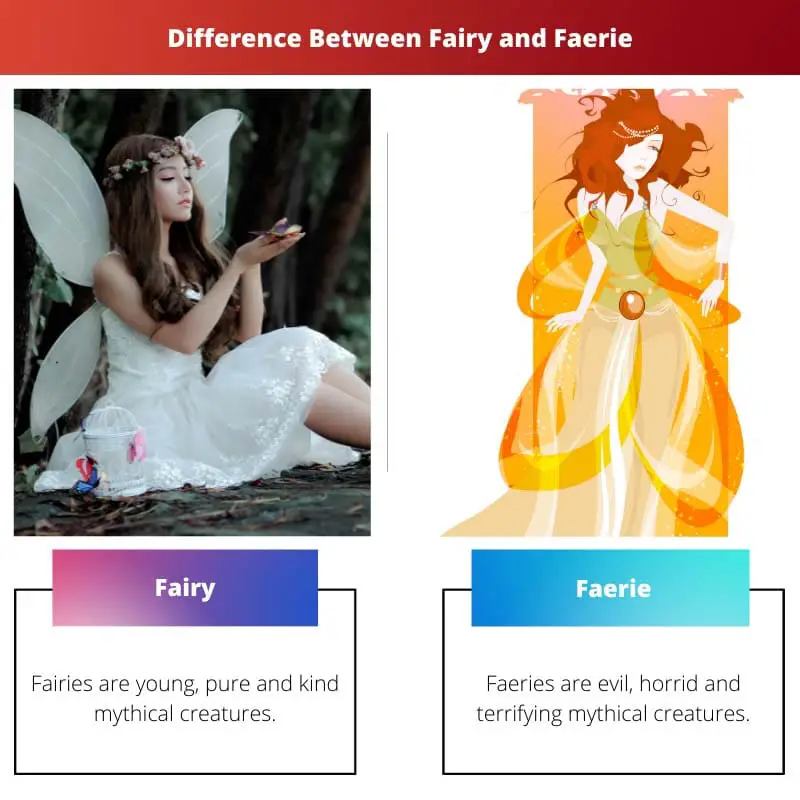The words fairy and faerie are used by people in the same sense and are thought to be just a difference in spelling and nothing much. But there are several differences between fairy and faerie.
They are both different mythical spirits.
Key Takeaways
- “Fairy” is a term used to describe mythical creatures with magical powers and human-like appearances, depicted with wings, while “faerie” refers to the realm or world in which these beings reside.
- The terms are sometimes used interchangeably, but “fairy” is more commonly used to denote supernatural beings, and “faerie” is primarily used in the context of folklore and mythology to describe their domain.
- Both concepts originate from European mythology and folklore, with variations in appearance, abilities, and behaviour depending on the specific cultural context.
Fairy vs. Faerie
Fairy is a term that refers to a fictitious creature representing a kind and pure soul. Fairy is mostly shown with wings having some magic. Faerie is a term that refers to a fictional creature having harmful intuition that can cause damage. They are depicted as troublesome creatures.

The fairies are mythical creatures described as small humanoid creatures with thin, membranous wings which tend to stay away from all humans and the human world. The fairies are mythical creatures who are like fairies except for their personality, which is evil and dangerously mischievous.
They are also associated with stealing. They are immortal beings and can only be killed by some special methods.
That is why many fairies and faeries are over a hundred years old. Modern fairies are described as glowing them.
The portrayal of fairies from the older times to the modern times can vary depending upon the type of fairy tale they are a part of.
For example, in the story of Cinderella, the fairy godmother is portrayed just like a human, whereas in the story of Peter Pan, Tinkle Bell is portrayed as a small creature with a glow to her.
Comparison Table
| Parameters of Comparison | Fairy | Faerie |
|---|---|---|
| Origin of the term | The word fairy has been derived from the Latin word “fatum” which means fate. | The word faerie has been derived from the Gaelic “fear side, ” meaning man of shee. |
| Personality | Fairies are young, pure, and kind mythical creatures. | Faeries are evil, horrid, and terrifying mythical creatures. |
| Looks | Fairies are very good-looking and pretty | Faeries are not as good-looking as fairies, and they look evil. |
| Behavior | They can be mischievous, but they are not dangerous. | They are very mischievous and can also cause damage and are dangerous. |
| Example | An example of a fairy is Tinker Bell and the fairy godmother of Cinderella. | Example of faerie is the banshees, goblins, and elves. |
What is Fairy?
The origin of the word fairy is the Latin word “fatum,” meaning fate. Fairies are small humanoid creatures with thin, membranous wings.
They are very good-looking. They are quite pretty, cute, and handsome.
They are kind, generous, and pure-hearted creatures. Also, fairies stay away from humans or the human world.
But they help small children and also play with them.
They do not show up in front of adults. They can be mischievous but can never be considered dangerous in any way.
Fairies are also immortal, but they are not indestructible. They can only be killed by special rituals or tools but never by illness and aging.
This is why some fairies are more than a hundred years old. Most fairies, as portrayed today, have an iridescent glow to them, and many of them are considered to be at least partially immortal.
They live in their world peacefully and help out each other. Examples of fairies include the fairy godmother of Cinderella, Tinker Bell in Peter Pan, and many others.

What is Faerie?
The origin of the word faerie is the Gaelic “fear shide,” meaning a man of shee. Faeries are considered to be very evil and horrifying and terrifying creatures.
These mythical creatures are not as pretty or handsome as the fairies. They are quite mischievous, and they can also be very dangerous.
They are associated with stealing children, who are then treated as slaves or pets by them. They have various powers to carry out such actions.
As fairies, faeries also are immortal. Special weapons can only kill them in specific situations.
Faeries cannot die of old age or any illness. Banshees, goblins, elves, and many more are examples of faeries.

Main Differences Between Fairy and Faerie
- The origin of the word fairy is from the Latin word “fatum” which means fate, whereas the origin of the word faerie is from the Gaelic “fear shide” which means man of shee.
- Fairies are good-looking, handsome, and pretty, while the faeries are not as pretty or good-looking as the fairies and look quite evil.
- Fairies are kind and pure-hearted mythical creatures, whereas faeries are evil, horrid, and terrifying mythical creatures.
- Fairies are quite mischievous, playing around but not dangerous, whereas faeries are very mischievous and dangerous.
- An example of a kind fairy is Tinker Bell, and an example of an evil faerie is Banshee.

- https://english.ufl.edu/imagetext/archives/v4_1/collins/index.shtml
- https://www.journals.uchicago.edu/doi/pdfplus/10.1086/387319

The article provides a detailed and informative overview of the differences between fairies and faeries, including their origin, appearance, and behavior.
I appreciate the comprehensive analysis of these mythical creatures. The distinctions in their appearances and behavior are well elaborated.
The article effectively highlights the significant differences between fairies and faeries, offering a thorough understanding of their unique characteristics.
The article effectively explains the contrasting qualities of fairies and faeries, shedding light on their respective origin, personality traits, and appearances.
The detailed comparison between fairies and faeries provides a comprehensive understanding of their attributes and depictions in mythology.
The article does a fantastic job of delving into the origins and characteristics of fairies and faeries, providing a thorough comparison of these mythological entities.
I couldn’t agree more! The analysis of their origin, looks, and behavior is truly enlightening.
The article offers an insightful analysis of fairies and faeries, highlighting their distinct personality traits, appearances, and mythological origins.
I agree, the detailed exploration of fairies and faeries is thought-provoking and enriching.
The article does a great job of explaining the differences between fairies and faeries, both which have European origins as mythical spirits but vary significantly in appearance, abilities, and behavior.
Absolutely, the article provides an insightful comparison where one term is associated with kind and pure mythical creatures, while the other denotes evil and mischievous beings.
I couldn’t agree more! It’s fascinating how two similar terms encompass such distinct qualities.
The detailed comparison of fairies and faeries offers valuable insights into the distinct characteristics and origins of these mythical beings.
The article effectively compares fairies and faeries, providing an in-depth understanding of their origins, looks, and behavior.
Indeed, the article offers a comprehensive analysis, shedding light on the significant differences between fairies and faeries.
The article’s detailed examination of fairies and faeries enriches our understanding of these mythical entities in folklore and literature.
The comparison between fairy and faerie is quite illuminating, especially in understanding their unique origins, personalities, and behaviors.
Absolutely, the article effectively portrays the differences in appearance, behavior, and origin of fairies and faeries.
I found the comparison table very helpful, outlining parameters of difference between fairies and faeries, including their origin, personality, looks, and behavior.
The article effectively explores the various aspects of fairies and faeries, shedding light on their origins, personality traits, and behavior.
Indeed, the specific examples of fairies and faeries further illustrate the distinctive characteristics associated with each term.
This is an interesting read, especially in the portrayal of fairies and faeries in different stories. The article effectively compares the characteristics of these mythical creatures.
Absolutely, the portrayal of fairies and faeries in various stories adds depth to the understanding of their traits and behaviors.
The comprehensive distinction between fairies and faeries is well-crafted, helping readers grasp their individual qualities and origins.